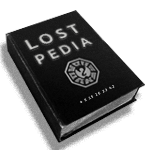Season: 6, Episodes: 5, Faction: Widmore

![]()
 Overview
Overview
Simmons was a technician in Widmore’s team at the Hydra station.


On the Island (2007)
6×11 – Happily Ever After
He was sent to check a short circuit in the solenoid chamber. When another technician threw a switch without waiting for the all clear, he was fried by the solenoid’s electromagnetic energy.
After he was carried out from the solenoid chamber, Widmore looks at his charred face in a brief goodbye. (“Happily Ever After”)
Related Character Images
Associated DHARMA Stations
Decoded Season 2 Characters
Decoded Season 6 Characters
Key Episode(s) to Decoding the Character
Solenoid Coil Chamber
 The solenoid coil chamber was a structure on the Hydra Island, used to create an electromagnetic field.
The solenoid coil chamber was a structure on the Hydra Island, used to create an electromagnetic field.
Structure
The chamber was located in a yard outside one of the Hydra station buildings. It was an enclosed white wooden structure, containing two large solenoid coils, with huge cables connecting it to the main building. When switched on, the solenoids would generate an intense electromagnetic field. A large metal stairway led up and into the main building from there.
History
When Charles Widmore and his team arrived at the Island in 2007, they set up the chamber.
They intended to use it to test whether or not Desmond Hume could survive another electromagnetic phenomenon. They tested it before putting Desmond inside. However a circuit failed and Simmons was sent to inspect it. Another worker found the fault, fixed it, and immediately switched the power back on, before Simmons was given time to exit. Simmons was killed by the electromagnetism and Desmond was forcefully put inside next. Desmond survived the event and was left unconscious. Although only unconscious for a few seconds, he experienced a portion of his life in the flash-sideways timeline. (“Happily Ever After”)
Wiki Info
Polyphemus is the gigantic one-eyed son of Poseidon and Thoosa in Greek mythology, one of the Cyclopes. His name means “everywhere famous”. Polyphemus plays a pivotal role in Homer’s Odyssey.
In Homer’s Odyssey
 In Homer’s Odyssey (Book 9), Odysseus lands on the Island of the Cyclopes during his journey home from the Trojan War. He takes with him twelve men to find food and drink, and they eventually find a large cave, which is the home of the great Cyclops Polyphemus. When Polyphemus returns home with his flocks and finds Odysseus and his men, he blocks the cave entrance with a great stone, trapping the remaining Greeks inside. Polyphemus then crushes and immediately devours two of his men for his meal. It is said that “rapping them on the ground, he knocked them dead like pups”.
In Homer’s Odyssey (Book 9), Odysseus lands on the Island of the Cyclopes during his journey home from the Trojan War. He takes with him twelve men to find food and drink, and they eventually find a large cave, which is the home of the great Cyclops Polyphemus. When Polyphemus returns home with his flocks and finds Odysseus and his men, he blocks the cave entrance with a great stone, trapping the remaining Greeks inside. Polyphemus then crushes and immediately devours two of his men for his meal. It is said that “rapping them on the ground, he knocked them dead like pups”.
The next morning, Polyphemus kills and eats two more of Odysseus’ men for his breakfast and exits the cave to graze his sheep. The desperate Odysseus devises a clever escape plan. He spots a massive unseasoned olivewood club that Polyphemus left behind the previous night and, with the help of his men, sharpens the narrow end to a fine point. He hardens the stake over a flame and hides it from sight. That night, Polyphemus returns from herding his flock of sheep. He sits down and kills two more of Odysseus’ men, bringing the death toll to six. At that point, Odysseus offers Polyphemus the strong and undiluted wine given to him by Maron. The wine makes Polyphemus drunk and unwary.
When Polyphemus asks for Odysseus’ name, promising him a guest-gift if he answers, Odysseus tells him “οὔτις,” literally “nobody.” Being drunk, Polyphemus thinks of it as a real name and says that he will eat “nobody” last and that this shall be his guest-gift—a vicious insult both to the tradition of hospitality and to Odysseus. With that, Polyphemus crashes to the floor and passes out. Odysseus, with the help of his men, lifts the flaming stake, charges forward and drives it into Polyphemus’ eye, blinding him. Polyphemus yells for help from his fellow cyclopes that “nobody” has hurt him. The other cyclopes think Polyphemus is making a fool out of them or that it must be a matter with the gods, and they grumble and go away.
In the morning, Odysseus and his men tie themselves to the undersides of Polyphemus’ sheep. When the blind Cyclops lets the sheep out to graze, he feels their backs to ensure the men aren’t riding out, but because of Odysseus’ plan, he does not feel the men underneath. Odysseus leaves last, riding beneath the belly of the biggest ram. Polyphemus doesn’t realize that the men are no longer in his cave until the sheep and the men are safely out.
As he sails away with his men, Odysseus boasts to Polyphemus that “I am not nobody; I am Odysseus, Son of Laertes, King of Ithaca.” This act of hubris causes problems for Odysseus later. Polyphemus prays to his father, Poseidon for revenge. Even though Poseidon fought on the side of the Greeks during the Iliad, he bore Odysseus a grudge for not giving him a sacrifice when Poseidon prevented them from being discovered inside of the Trojan Horse. Poseidon curses Odysseus, sending storms and contrary winds to inhibit his homeward journey.
The episode in Odyssey is the oldest testament to cannibalism in ancient Greek literature. Walter Burkert detects in the Polyphemus episode a subtext that “seems to offer us something more ancient: threatened by the man-eater, men conceal themselves in the skins of slaughtered animals, and thus, disguised as animals, escape the groping hands of the blinded monster.” The vivid nature of the Polyphemus episode in the Odyssey made it a favorite theme of ancient Greek painted pottery, both Black-figure and Red-figure pottery.
Mythological Family Members & Associated Deities

CYCLOPS
A cyclops in Greek mythology and later Roman mythology, was a member of a primordial race of giants, each with a single eye in the middle of his forehead. The name is widely thought to mean “circle-eyed”.
Hesiod described one group of cyclopes and the epic poet Homer described another, though other accounts have also been written by the playwright Euripides, poet Theocritus and Roman epic poet Virgil. In Hesiod’s Theogony, Zeus releases three Cyclopes, the sons of Uranus and Gaia, from the dark pit of Tartarus. They provide Zeus’ thunderbolt, Hades‘ helmet of invisibility, and Poseidon’s trident, and the gods use these weapons to defeat the Titans.
In a famous episode of Homer’s Odyssey, the hero Odysseus encounters the Cyclops Polyphemus, the son of Poseidon and Thoosa (a nereid), who lives with his fellow Cyclopes in a distant country. The connection between the two groups has been debated in antiquity and by modern scholars. It is upon Homer’s account that Euripides and Virgil based their accounts of the mythical creatures.
Mythology and Literature
Various ancient Greek and Roman authors wrote about the cyclopes. Hesiod described them as three brothers who were primordial giants. All the other sources of literature about the cyclopes describe the cyclops Polyphemus, who lived upon an island populated by the creatures.
Hesiod
 In the Theogony by Hesiod, the Cyclopes – Brontes (“thunderer”), Steropes (“lightning”) and the “bright” Arges – were the primordial sons of Uranus (Sky) and Gaia (Earth) and brothers of the Hecatonchires. They were giants with a single eye in the middle of their forehead and a foul disposition. According to Hesiod, they were strong, stubborn, and “abrupt of emotion”. Collectively they eventually became synonyms for brute strength and power, and their name was invoked in connection with massive masonry. They were often pictured at their forge.
In the Theogony by Hesiod, the Cyclopes – Brontes (“thunderer”), Steropes (“lightning”) and the “bright” Arges – were the primordial sons of Uranus (Sky) and Gaia (Earth) and brothers of the Hecatonchires. They were giants with a single eye in the middle of their forehead and a foul disposition. According to Hesiod, they were strong, stubborn, and “abrupt of emotion”. Collectively they eventually became synonyms for brute strength and power, and their name was invoked in connection with massive masonry. They were often pictured at their forge.
Uranus, fearing their strength, locked them in Tartarus. Cronus, another son of Uranus and Gaia, later freed the Cyclopes, along with the Hecatonchires, after he had overthrown Uranus. Cronus then placed them back in Tartarus, where they remained, guarded by the female dragon Campe, until freed by Zeus. They fashioned thunderbolts for Zeus to use as weapons, and helped him overthrow Cronus and the other Titans. The lightning bolts, which became Zeus’s main weapons, were forged by all three Cyclopes, in that Arges added brightness, Brontes added thunder, and Steropes added lightning.
These Cyclopes also created Poseidon’s trident, Artemis’s bow and arrows of moonlight, Apollo’s bow and arrows of sun rays, and Hades’s helmet of darkness that was given to Perseus on his quest to kill Medusa.
Callimachus
According to a hymn of Callimachus, they were Hephaestus‘ helpers at the forge. The Cyclopes were said to have built the “cyclopean” fortifications at Tiryns and Mycenae in the Peloponnese. The noises proceeding from the heart of volcanoes were attributed to their operations.
Euripides
According to Alcestis by Euripides, Apollo killed the Cyclopes, in retaliation for Asclepius’s murder at the hands of Zeus. According to Euripides’ play Alkestis, Apollo was then forced into the servitude of Admetus for one year. Zeus later returned Asclepius and the Cyclopes from Hades.
Theocritus
The Sicilian Greek poet Theocritus wrote two poems circa 275 BC concerning Polyphemus’ desire for Galatea, a sea nymph. When Galatea instead married Acis, a Sicilian mortal, a jealous Polyphemus killed him with a boulder. Galatea turned Acis’ blood into a river of the same name in Sicily.
Virgil
Virgil, the Roman epic poet, wrote, in book three of The Aeneid, of how Aeneas and his crew landed on the island of the cyclops after escaping from Troy at the end of the Trojan War. Aeneas and his crew land on the island, when they are approached by a desperate Greek man from Ithaca, Achaemenides, who was stranded on the island a few years previously with Odysseus’ expedition (as depicted in The Odyssey).
Virgil’s account acts as a sequel to Homer’s, with the fate of Polyphemus as a blind cyclops after the escape of Odysseus and his crew.









































You must be logged in to post a comment.